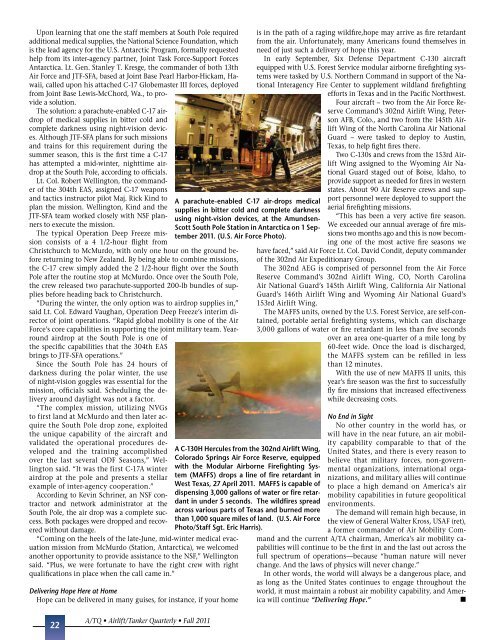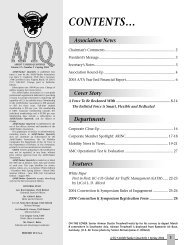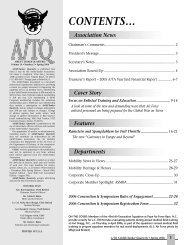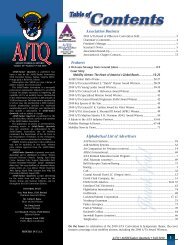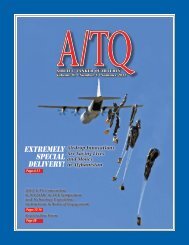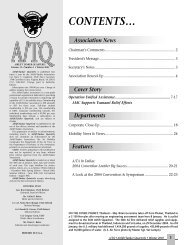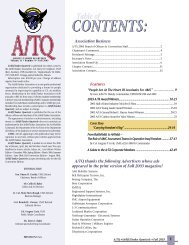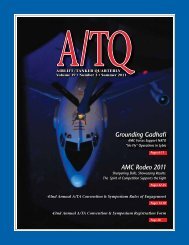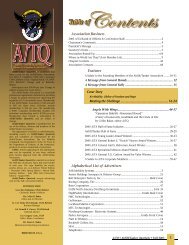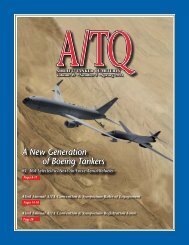A Salute to the A/TA Industry Partners - Airlift/Tanker Association
A Salute to the A/TA Industry Partners - Airlift/Tanker Association
A Salute to the A/TA Industry Partners - Airlift/Tanker Association
You also want an ePaper? Increase the reach of your titles
YUMPU automatically turns print PDFs into web optimized ePapers that Google loves.
Upon learning that one <strong>the</strong> staff members at South Pole requiredadditional medical supplies, <strong>the</strong> National Science Foundation, whichis <strong>the</strong> lead agency for <strong>the</strong> U.S. Antarctic Program, formally requestedhelp from its inter-agency partner, Joint Task Force-Support ForcesAntarctica. Lt. Gen. Stanley T. Kresge, <strong>the</strong> commander of both 13thAir Force and JTF-SFA, based at Joint Base Pearl Harbor-Hickam, Hawaii,called upon his attached C-17 Globemaster III forces, deployedfrom Joint Base Lewis-McChord, Wa., <strong>to</strong> providea solution.The solution: a parachute-enabled C-17 airdropof medical supplies in bitter cold andcomplete darkness using night-vision devices.Although JTF-SFA plans for such missionsand trains for this requirement during <strong>the</strong>summer season, this is <strong>the</strong> first time a C-17has attempted a mid-winter, nighttime airdropat <strong>the</strong> South Pole, according <strong>to</strong> officials.Lt. Col. Robert Welling<strong>to</strong>n, <strong>the</strong> commanderof <strong>the</strong> 304th EAS, assigned C-17 weaponsand tactics instruc<strong>to</strong>r pilot Maj. Rick Kind <strong>to</strong>plan <strong>the</strong> mission. Welling<strong>to</strong>n, Kind and <strong>the</strong>JTF-SFA team worked closely with NSF planners<strong>to</strong> execute <strong>the</strong> mission.The typical Operation Deep Freeze missionconsists of a 4 1/2-hour flight fromChristchurch <strong>to</strong> McMurdo, with only one hour on <strong>the</strong> ground beforereturning <strong>to</strong> New Zealand. By being able <strong>to</strong> combine missions,<strong>the</strong> C-17 crew simply added <strong>the</strong> 2 1/2-hour flight over <strong>the</strong> SouthPole after <strong>the</strong> routine s<strong>to</strong>p at McMurdo. Once over <strong>the</strong> South Pole,<strong>the</strong> crew released two parachute-supported 200-lb bundles of suppliesbefore heading back <strong>to</strong> Christchurch.“During <strong>the</strong> winter, <strong>the</strong> only option was <strong>to</strong> airdrop supplies in,”said Lt. Col. Edward Vaughan, Operation Deep Freeze’s interim direc<strong>to</strong>rof joint operations. “Rapid global mobility is one of <strong>the</strong> AirForce’s core capabilities in supporting <strong>the</strong> joint military team. Yearroundairdrop at <strong>the</strong> South Pole is one of<strong>the</strong> specific capabilities that <strong>the</strong> 304th EASbrings <strong>to</strong> JTF-SFA operations.”Since <strong>the</strong> South Pole has 24 hours ofdarkness during <strong>the</strong> polar winter, <strong>the</strong> useof night-vision goggles was essential for <strong>the</strong>mission, officials said. Scheduling <strong>the</strong> deliveryaround daylight was not a fac<strong>to</strong>r.“The complex mission, utilizing NVGs<strong>to</strong> first land at McMurdo and <strong>the</strong>n later acquire<strong>the</strong> South Pole drop zone, exploited<strong>the</strong> unique capability of <strong>the</strong> aircraft andvalidated <strong>the</strong> operational procedures developedand <strong>the</strong> training accomplishedover <strong>the</strong> last several ODF Seasons,” Welling<strong>to</strong>nsaid. “It was <strong>the</strong> first C-17A winterairdrop at <strong>the</strong> pole and presents a stellarexample of inter-agency cooperation.”According <strong>to</strong> Kevin Schriner, an NSF contrac<strong>to</strong>rand network administra<strong>to</strong>r at <strong>the</strong>South Pole, <strong>the</strong> air drop was a complete success.Both packages were dropped and recoveredwithout damage.“Coming on <strong>the</strong> heels of <strong>the</strong> late-June, mid-winter medical evacuationmission from McMurdo (Station, Antarctica), we welcomedano<strong>the</strong>r opportunity <strong>to</strong> provide assistance <strong>to</strong> <strong>the</strong> NSF,” Welling<strong>to</strong>nsaid. “Plus, we were fortunate <strong>to</strong> have <strong>the</strong> right crew with rightqualifications in place when <strong>the</strong> call came in.”Delivering Hope Here at HomeHope can be delivered in many guises, for instance, if your homeA parachute-enabled C-17 air-drops medicalsupplies in bitter cold and complete darknessusing night-vision devices, at <strong>the</strong> Amundsen-Scott South Pole Station in Antarctica on 1 September2011. (U.S. Air Force Pho<strong>to</strong>).A C-130H Hercules from <strong>the</strong> 302nd <strong>Airlift</strong> Wing,Colorado Springs Air Force Reserve, equippedwith <strong>the</strong> Modular Airborne Firefighting System(MAFFS) drops a line of fire retardant inWest Texas, 27 April 2011. MAFFS is capable ofdispensing 3,000 gallons of water or fire retardantin under 5 seconds. The wildfires spreadacross various parts of Texas and burned morethan 1,000 square miles of land. (U.S. Air ForcePho<strong>to</strong>/Staff Sgt. Eric Harris).is in <strong>the</strong> path of a raging wildfire,hope may arrive as fire retardantfrom <strong>the</strong> air. Unfortunately, many Americans found <strong>the</strong>mselves inneed of just such a delivery of hope this year.In early September, Six Defense Department C-130 aircraftequipped with U.S. Forest Service modular airborne firefighting systemswere tasked by U.S. Nor<strong>the</strong>rn Command in support of <strong>the</strong> NationalInteragency Fire Center <strong>to</strong> supplement wildland firefightingefforts in Texas and in <strong>the</strong> Pacific Northwest.Four aircraft – two from <strong>the</strong> Air Force ReserveCommand’s 302nd <strong>Airlift</strong> Wing, PetersonAFB, Colo., and two from <strong>the</strong> 145th <strong>Airlift</strong>Wing of <strong>the</strong> North Carolina Air NationalGuard – were tasked <strong>to</strong> deploy <strong>to</strong> Austin,Texas, <strong>to</strong> help fight fires <strong>the</strong>re.Two C-130s and crews from <strong>the</strong> 153rd <strong>Airlift</strong>Wing assigned <strong>to</strong> <strong>the</strong> Wyoming Air NationalGuard staged out of Boise, Idaho, <strong>to</strong>provide support as needed for fires in westernstates. About 90 Air Reserve crews and supportpersonnel were deployed <strong>to</strong> support <strong>the</strong>aerial firefighting missions.“This has been a very active fire season.We exceeded our annual average of fire missionstwo months ago and this is now becomingone of <strong>the</strong> most active fire seasons wehave faced,” said Air Force Lt. Col. David Condit, deputy commanderof <strong>the</strong> 302nd Air Expeditionary Group.The 302nd AEG is comprised of personnel from <strong>the</strong> Air ForceReserve Command’s 302nd <strong>Airlift</strong> Wing, CO, North CarolinaAir National Guard’s 145th <strong>Airlift</strong> Wing, California Air NationalGuard’s 146th <strong>Airlift</strong> Wing and Wyoming Air National Guard’s153rd <strong>Airlift</strong> Wing.The MAFFS units, owned by <strong>the</strong> U.S. Forest Service, are self-contained,portable aerial firefighting systems, which can discharge3,000 gallons of water or fire retardant in less than five secondsover an area one-quarter of a mile long by60-feet wide. Once <strong>the</strong> load is discharged,<strong>the</strong> MAFFS system can be refilled in lessthan 12 minutes.With <strong>the</strong> use of new MAFFS II units, thisyear’s fire season was <strong>the</strong> first <strong>to</strong> successfullyfly fire missions that increased effectivenesswhile decreasing costs.No End in SightNo o<strong>the</strong>r country in <strong>the</strong> world has, orwill have in <strong>the</strong> near future, an air mobilitycapability comparable <strong>to</strong> that of <strong>the</strong>United States, and <strong>the</strong>re is every reason <strong>to</strong>believe that military forces, non-governmentalorganizations, international organizations,and military allies will continue<strong>to</strong> place a high demand on America’s airmobility capabilities in future geopoliticalenvironments.The demand will remain high because, in<strong>the</strong> view of General Walter Kross, USAF (ret),a former commander of Air Mobility Commandand <strong>the</strong> current A/<strong>TA</strong> chairman, America’s air mobility capabilitieswill continue <strong>to</strong> be <strong>the</strong> first in and <strong>the</strong> last out across <strong>the</strong>full spectrum of operations—because “human nature will neverchange. And <strong>the</strong> laws of physics will never change.”In o<strong>the</strong>r words, <strong>the</strong> world will always be a dangerous place, andas long as <strong>the</strong> United States continues <strong>to</strong> engage throughout <strong>the</strong>world, it must maintain a robust air mobility capability, and Americawill continue “Delivering Hope.”22A/TQ • <strong>Airlift</strong>/<strong>Tanker</strong> Quarterly • Fall 2011


